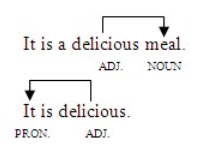Adjectives, adverbs & adverbials
Adjectives and adverbs are word classes, and they have very different uses in sentences. The adverbial (A) is a clausal element
|
Adjectives have only one job: they describe nouns or pronouns
Adjectives may come before the word they modify.
Adjectives may also follow the word they modify:
|
Adverbs have three different uses. They can describe verbs, adjectives, or other adverbs.
Adverbs answer how, when, where, why, or to what extent—how often or how much (e.g., daily, completely).
|

